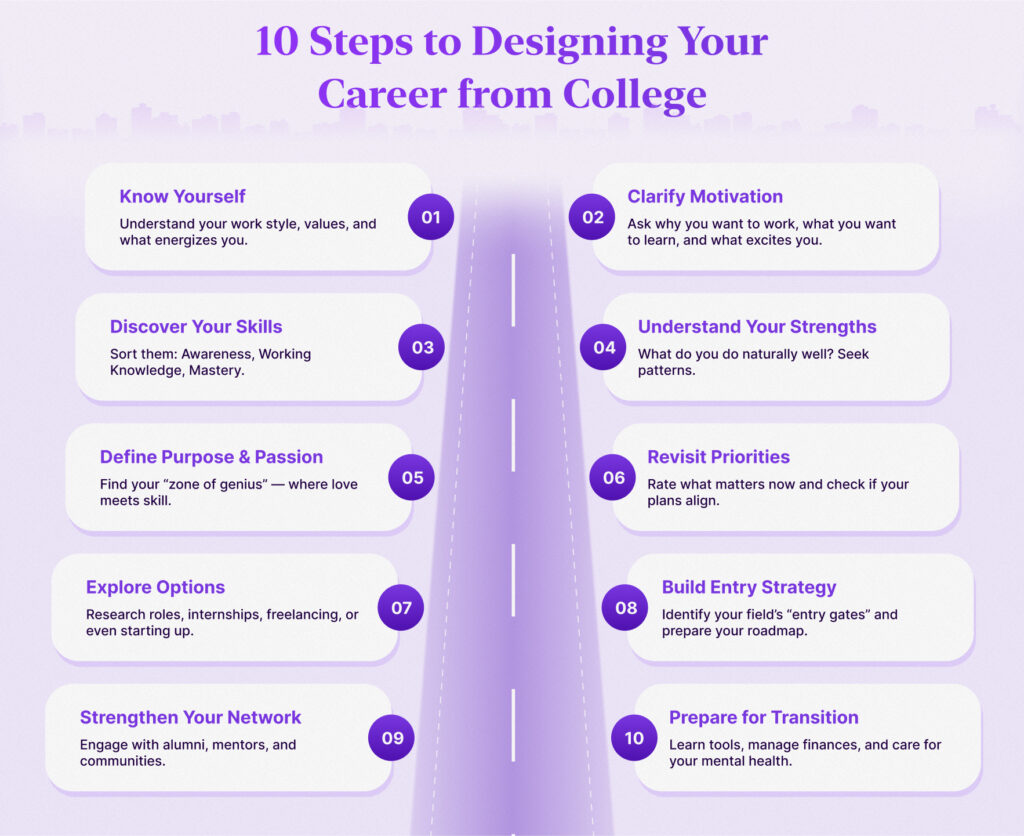Blog > Navigating the New World of Work, Students
Designing Your Career from College: A Guide to Owning Your Future

As you approach the end of your college adventure, resume building, internships, and placements are likely what you’re hearing a lot about. Students miss a better chance, which exists past the excitement. To choose your first job, it is a part of it. To begin the process of designing a career aligned with your aspirations, skills, interests, as well as values is what it’s about.
In a world where industries are evolving rapidly as the idea of a “stable job” is constantly being redefined, how well your career aligns to your strengths, to passions, to life stage, and to long-term goals is what truly matters. We deliberately mold the most satisfying jobs. These careers are not ones into which we fall by default.
This guide will help you take a structured approach to make your first step into the world of work both intentional and inspiring.

Step 1: Know Yourself
Before you search for the “right job,” start by understanding who you are. Your career decisions should not be driven by market trends alone, but by a deep understanding of your own motivations.
Ask yourself:
- What kind of problems do I enjoy solving?
- When do I feel most engaged, is it while creating, collaborating, analysing, helping?
- What environments bring out my best performance: fast-paced, structured, creative, independent?
Use reflective tools like journaling, conversations with mentors, or guided assessments to uncover your working style, values, and energy sources. The goal here is not to label yourself but to observe patterns in what energizes or depletes you.
Step 2: Clarify Your Motivation
Not every student knows exactly what they want and that’s okay. But having clarity on why you want to start working in a particular role or domain will give you a sense of purpose that employers also value.
Questions to reflect on:
- Why do I want to start working right now?
- What am I hoping to learn in my first job?
- What kind of exposure or experience do I want in the next 2 years?
- If money wasn’t a factor, what kind of work would I do?
Even if your answers change over time, this early clarity can help you make more aligned choices.
Step 3: Discover Your Skills
You already have more skills than you think. Whether it’s managing group projects, volunteering, part-time work, or internships, every experience has helped you build a skillset.
Map your skills into three categories:
- Awareness: You have been introduced to this skill (e.g., project management).
- Working Knowledge: You’ve applied it in real situations (e.g., Canva for design, Excel for budgeting).
- Mastery: You’ve consistently performed well and can teach others (e.g., public speaking, coding, leadership in clubs).
Start creating a “skills portfolio” where you document what you’ve done, how you did it, and what skills it demonstrates. This will help you articulate your value during interviews or applications.
Step 4: Understand Your Strengths
Skills are what you can do. Strengths are what you do well, naturally and repeatedly.
Use tools like Gallup’s CliftonStrengths or VIA Character Strengths. Or simply ask:
- What feedback have I consistently received from peers, professors, mentors?
- What do people come to me for help with?
- When have I felt “in flow” fully focused and effective?
Your strengths are your career’s unfair advantage. They will shape not only what you can do, but how you thrive while doing it.
Step 5: Define Your Purpose and Passion
Purpose doesn’t arrive as a lightning bolt. It’s shaped by curiosity, experiences, and the impact you want to create. Passion, similarly, is born at the intersection of what you love and what you’re great at.
Here’s an exercise:
- Write down 50 things you love doing or admire about yourself, big or small.
- Write another list of things you’re genuinely good at.
- Highlight the overlaps. This is your “zone of genius”, where you should aim to operate in your career.
Then, ask:
- What kind of impact do I want to have?
- Who do I want to help or serve?
- What would make me proud five years from now?
Your career will evolve, but a strong sense of purpose will keep you anchored.
Step 6: Revisit Your Priorities
As a student, your priorities may include financial independence, work-life balance, travel, family expectations, or the desire to explore different fields. Your career decisions should honour these priorities without sacrificing long-term potential.
Create a two-column list:
- In column one, rate what’s most important to you right now (on a scale of 1 to 10).
- In column two, rate how much your current plans or decisions reflect these priorities.
Any gap you see is a signal. This is where you need alignment between your vision and your next steps.
Step 7: Explore Possibilities and Options
The job market is full of opportunities, but not all of them are right for you. Begin by researching roles where your skills, interests, and values intersect.
Start with:
- Campus placement roles
- Internships and apprenticeships
- Fellowships and graduate programs
- Freelancing or project-based work
- Starting your own venture or social initiative
Speak to professionals in your desired field. Ask what their day-to-day looks like. Understand the growth path. This clarity will guide your applications and interviews.
Step 8: Build Your Entry Strategy
Once you’ve shortlisted a few career options, define your “entry gate.”
Each field has its own entry point. For instance, product management may need internships and case competitions, while a startup may value demonstrated initiative over GPA.
To build your entry strategy:
- Create a roadmap of the skills and experiences required.
- Identify the certifications, courses, or mentors who can help.
- Build a timeline: what can be achieved in the next 3, 6, and 12 months?
Step 9: Strengthen Your Network
Your network is your net worth and that starts in college. Begin with your professors, alumni, peers, and guest speakers. Reach out on LinkedIn. Ask questions, show curiosity, and express your career interests.
Take these steps:
- Join communities in your field of interest.
- Attend webinars, talks, and industry events.
- Start publishing your thoughts: blogs, LinkedIn posts, or project reports.
You don’t need to have all the answers. You just need to show up with intent.
Step 10: Prepare for Transition
The move from student to professional is not just a change in title, it’s a mindset shift. Use this time to strengthen your digital skills, develop financial literacy, and prioritize your physical and emotional well-being.
Here’s what to focus on:
- Digital Agility: Learn basic tools relevant to your field. Stay updated on AI, data, and automation.
- Financial Planning: Understand income, savings, taxes, and budgeting.
- Mental Wellness: Build habits that support rest, reflection, and self-regulation.
Treat the transition not as a destination but the beginning of your career design journey.
Final Thought
You are not here just to “get placed.” You are here to build a career that evolves with you, challenges you, and brings you joy and meaning. Designing your career is a lifelong practice. This guide is only your starting point. The rest will unfold with every decision, every conversation, and every step you take with awareness and intention.
